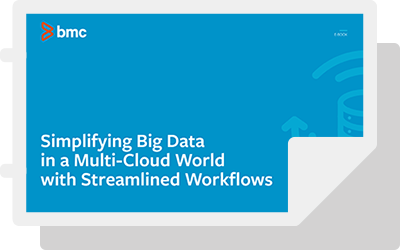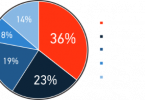Data Fabric lets organizations take control of data residing anywhere, anytime. Data Fabric encompasses the technology architecture and IT services that enable this capability by simplifying and integrating data management processes across all sources and access points of data. Specifically for hybrid cloud infrastructure deployments that require organizations to manage data access, security, control and visibility using multiple different data management frameworks, Data Fabric works as a single and consistent data management framework.
Essentially, Data Fabric can be described as a converged platform supporting the diverse data management needs to deliver the right IT service levels across all disparate data sources and infrastructure types. It operates as a consolidated framework to manage, move and protect data across multiple isolated and incompatible data center deployments. As a result, organizations can invest in infrastructure solutions that align with their business requirements, without concerns surrounding data service levels, access and security.
Computing resources are stateless and can dynamically transition across infrastructure or terminated as needed. Data by nature is stateful and must be accessible on a continuous basis to deliver data-enabled IT services or perform analytics. In order to take advantage of the most available, cost-effective and scalable computing resources, organizations need to leverage multiple infrastructure instances from hybrid cloud deployments.
Ideally, data should be stored closer to the computing resources. Considering the vast sources, access points and storage locations of data, it’s not practically possible to migrate data every time new and different computing resource are initiated from disparate and distant data center locations. Finally, several requirements around security, availability and compliance apply consistently to data regardless of the infrastructure location. If the data has to move, the protection and compliance mechanism must apply consistently across the new data locations. To address these requirements, Data Fabric offers the following key components and properties:
- Unified Data Environment: Merging the systems and tooling for Big Data access and analytics into a single platform or framework allows the flexibility to maintain storage in disparate infrastructure deployments. Data Fabric enables a cohesive analytics environment, allowing seamless data access and processing across otherwise siloed storage locations.
- Enable Multiple Data Access Sources: Data Fabric covers multiple sources of data – in the cloud, on-premise, at the edge and other storage locations. Instead of maintaining a centralized data repository or migrating data between different sources, the data management framework supports an increasing number of data access sources and storage locations.
- Reliability and Security: Data Fabric by design maintains security and reliable access of data irrespective of the storage location. The security protection, backup and disaster recovery protocols apply consistently across the infrastructure. As a result, organizations can enforce the necessary security and risk management policies based on stringent and varying compliance requirements across global data centers.
- High Availability and Service Levels: Organizations can choose to maintain consistent service levels for the data in hybrid cloud environments based on requirements around IT responsiveness, service levels, security and reliability, risk and overhead costs, among other key considerations.
With these properties, Data Fabric offers organizations a range of business value propositions by addressing the technical challenges of operating data services in a hybrid cloud environment:
- Operate a True Hybrid Cloud: When organizations invest in cloud storage and infrastructure solutions, their choice is based on cost, security, availability, scalability and service requirements. These requirements evolve over time, forcing them to switch vendors or pursue different cloud models as viable alternatives. Vendors on the other hand, tend to lock customers into their service, making data migration a costly and challenging endeavor for their customers. Data Fabric allows organizations to overcome the technical challenges in maintaining a diverse portfolio of data storage and infrastructure deployments. Customers can leverage the freedom to operate mission-critical data-driven IT services, apps, storage and access from a range of hybrid IT infrastructure resources based on changing technical and business requirements.
- Seamless Cloud Compute Transitions: Data Fabric is designed to mitigate disruptions in switching between cloud vendors and compute resources to process data stored in disparate locations. As a result, Data Fabric reduces time to insights dramatically. With faster insights, organizations can identify patterns within data, understand trends and make decisions proactively. Better decisions through improved compute performance across all channels of data ensure that businesses leapfrog market competition while making the most of their data investments.
- High Performance and Optimized Data Investments: Organizations invest significant resources and efforts into delivering the best performance for their apps and services. This is especially true for mission-critical apps that may be required to process a growing volume of data as the userbase grows or to accommodate unpredictable peak usage demands. In order to address these demands, organizations must also invest in cloud storage solutions that promise the desired performance levels. Similarly, the app or service may evolve into a legacy solution of tomorrow and the usage requirement may reduce accordingly. Either way, the app should be capable of delivering predictable performance whether the data is available at a highly available storage location or a low-cost economy storage infrastructure. With Data Fabric, organizations can realize this capability and optimize their data investments based on evolving app usage requirements.
- Future Proofing and the Flexibility to Evolve: Data Fabric allows organizations the flexibility to adapt their infrastructure based on changing technology needs. Data Fabric makes it easy to connect various infrastructure endpoints to the consolidated and unified data management framework. Organizations don’t have to worry about the explicit location of the data. If a startup firm invests in low-cost cloud storage solution until the company gains traction and needs highly available storage capacity at a later stage, it can leverage the flexibility that Data Fabric offers to choose infrastructure environments that best fit the nature of data and business requirements of the organization on an ongoing basis. The data management functionality will apply across all infrastructure deployments and organizations can future proof their data investments accordingly.
Organizations are seeking new IT service delivery models to address the changing technology requirements of their data-driven businesses. Challenges associated with data management however, tend to limit their options. Data Fabric has emerged as a viable solution to address these challenges and allow organizations the flexibility they need to opt for a truly viable hybrid cloud infrastructure. Gartner predicts that 90 percent of the organizations will adopt hybrid cloud infrastructure management capabilities by the year 2020. Considering the focus on data as a primary factor for deciding between hybrid infrastructure options, Data Fabric might well emerge as a necessary technology to facilitate optimized and effective adoption of hybrid cloud technologies.







